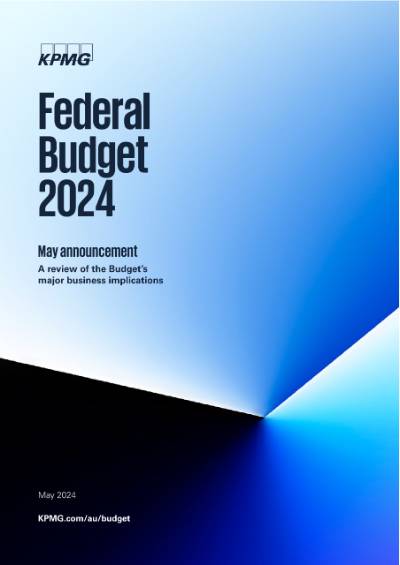Australian Federal Budget 2024: news as it happened
On Tuesday 14 May 2024, Treasurer Jim Chalmers handed down the 2024-25 Australian Federal Budget with updates to key economic forecasts.
From personal and business tax to banking, superannuation, infrastructure, health, defence, climate change, and more, the Federal Budget has implications for every corner of the Australian economy and impacts our status on the global stage.
KPMG’s team of experts provides full analysis following the Federal Budget announcement outlining insights and implications for various sectors and businesses. Our analysis is aimed at helping you prepare for any implications that may affect your business.
Federal Budget – by topic
Select a topic below to view KPMG's in-depth analysis
Executive summary
The Budget shows an expected surplus in the underlying cash balance for 2023-24 of $9.3 billion, a $10.4 billion positive turnaround from the 2023-24 mid-year forecast. Higher commodity prices and personal income tax receipts contributed heavily to the outcome.
Federal Government net debt is expected to remain reasonably stable as a percentage of GDP at between 20 and 22 percent over the forward estimates.
Inflation is forecast by Treasury to moderate to below 3 percent per annum for 2024-25 and the remainder of the forward estimates period. Contributing to this outcome is the extension of the Energy Bill Relief Fund, providing $3.5 billion in support through to 2025-26.
The Future Made in Australia initiative emphasises clean energy and critical minerals and includes more than $13 billion over the period to 2034 (weighted towards the years beyond the current inflation challenge) to fund tax incentives for their production.
The Budget contains additional funding for social and affordable housing infrastructure over the next decade. This should support productivity, including where it enables workers to live closer to their workplace and to other facilities. The increase to Commonwealth Rent Assistance is a sensible complement to these measures.
We also welcome the introduction of superannuation contributions on government-paid parental leave from 1 July 2025, promoting improved gender equality in retirement.
The funding for the development of policies and capabilities to support safe and responsible adoption of Artificial Intelligence technology is also a welcome announcement.
Overall, the Budget measures on energy and housing affordability, combined with the already legislated personal income tax cuts from 1 July 2024, may give households more confidence that cost-of-living pressures will abate.
As regards to the productivity challenge, the success of the Future Made in Australia initiative requires education, training, migration, industrial and fiscal policy to all combine constructively. If Australia can achieve this, then the prize may be significant.
Key contacts


Get in touch and we'll help you prepare for any implications that may affect your business.
Economic analysis
The Budget is not a cash-splash budget. Equally, it is not a budget designed to consolidate the nation's fiscal position and commence the task of gradually returning the budget to a sustainable position.
The budget contains a range of explicit measures aligned with the philosophy of the Albanese Government, which pivots the economy towards one where government plays a greater role, places greater emphasis on manufacturing in Australia and relies less on overseas supply chains.
New government spending is not just targeted at the poorest and most vulnerable in society; significant expenditure is targeted at the business sector to provide energy cost relief, and investment to support the Future Made in Australia program.
The Budget contains a whole raft of measures that fit neatly into these three themes:
- tax relief for everyone, but additional tax relief for low-and-middle income earners who also received tax cuts in the earlier Stages 1 and 2.
- cost of living support in the form of energy bill relief of a $300 rebate received by every household; and an additional 10 percent increase in Commonwealth Rental Assistance for nearly 1 million households renting.
- the introduction of the nearly $23 billion Future Made in Australia program aimed at encouraging domestic private sector investment in the transformation required for the country to achieve net zero emissions.
The Treasurer has been at pains to explain that the Australian Bureau of Statistics has confirmed that energy bill relief cuts inflation too. This is technically correct – the rebate is provided to energy companies to reduce the revenue they need to recover from customers, and therefore energy bills are lower than they otherwise would be. However, the production costs associated with supplying energy are unchanged; it is just the price paid by customers through their energy bill is lower because of the rebate. Once the rebate is withdrawn the prices paid by households will rebound (assuming there has been no change in the production cost of electricity), and inflation will increase again.
In the Budget the Treasurer has been able to tell the public the story of two surpluses in 2 years. Unfortunately, the Treasurer's narrative is now expected to permanently change, with surpluses unlikely for the foreseeable future.
However, the Treasurer does not seem to be overly concerned about future surpluses given that there is nothing in the Budget addressing revenue or expenditure reforms. Either the philosophy revealed in this Budget incorporates the view that long-term structural budget deficits are not a problem (which goes against economic fundamentals), or the government is 'kicking the can' down the road. Alternatively, they may be hoping for productivity to re-emerge and help solve part of the problem.
Economic assumptions
We summarise the assumptions underlying the Budget in the tables below:
The Treasury forecasts suggest the Australian economy will remain weak over the forecast period and only start to return to rates of economic growth similar to long term averages in 2027-28. Real GDP is forecast to grow by 1.75 percent during the current 2023-24 financial year and then increase by 0.25 percent per annum over the following 3 years to achieve growth of 2.00 percent (2024-25), 2.25 percent (2025-26) and 2.50 percent (2026-27). The current weakness in the domestic economy is largely due to flat household consumption and falling dwelling investment, offset to some extent by strong public sector spending and solid private sector investment activity (although this is expected to weaken in the next few years). Net exports add positively to economic growth during 2023-24, although with the usual assumptions that the spot price of iron ore and metallurgical coal reverting to a long-term price target significantly below current levels, net exports are expected to detract from economic growth by 2025-26.
| 2023-24 | 2024-25 | 2025-26 | 2026-27 | 2027-28 | |
|---|---|---|---|---|---|
| Real GDP | 1.75% | 2.00% | 2.25% | 2.50% | 2.75% |
The inflation forecasts contained within the Budget show a pathway to a return to the target inflation band that is significantly different to the most recent forecasts presented by the RBA in their May 2024 Edition of the Statement of Monetary Policy. The government is suggesting that the Energy Price Relief Plan and the extension of the Commonwealth Rental Assistance payments will together directly reduce headline inflation by 0.50 percent in 2024-25. Further, the strong fall in inflation over the coming year is also due to the continued reduction in services inflation which has lagged the decline in goods inflation.
| 2023-24 | 2024-25 | 2025-26 | 2026-27 | 2027-28 | |
|---|---|---|---|---|---|
| Inflation | 3.50% | 2.75% | 2.75% | 2.50% | 2.50% |
The labour market is forecast to weaken slightly over the forecast period with the unemployment rate pushing up to 4 percent by June 2024 and then stabilising at 4.5 percent for the following 2 years. This stabilisation in the labour market pushes down expected wages growth to low-to-mid 3 percent range over the forecast period. While weaker than nominal wage growth currently being achieved the concurrent fall in inflation means real wages growth strengthens from around 0.5 percent in the early years to 1.0 percent in the outer years.
| 2023-24 | 2024-25 | 2025-26 | 2026-27 | 2027-28 | |
|---|---|---|---|---|---|
| Wages | 4.00% | 3.25% | 3.25% | 3.50% | 3.50% |
What does it mean for you?
- The Albanese Government is taking a much more interventionist approach to economic development and government support for low, and stretching into middle, income households.
- Inflation forecasts are materially different to the latest RBA forecasts. If the government is wrong, then the implication is for the cash rate to stay higher for longer; which will in effect could result in higher mortgage payments that would more than offset any cost of living relief provided in the budget.
Key contact

Get in touch and we'll help you prepare for any implications that may affect your business.
Demographics
What the Budget means for different demographics
Demographic Group
2024-2025 Outlook
| Jobseeker recipients |
|---|
| Economic outlook | Budget outlook |
|---|---|
|
|
| Aged pensioners |
|---|
| Economic outlook | Budget outlook |
|---|---|
|
|
| Renters |
|---|
| Economic outlook | Budget outlook |
|---|---|
|
|
| Recent first home buyers |
|---|
| Economic outlook | Budget outlook |
|---|---|
|
|
ABS Census 2021
Benefit and Payment Recipient Demographics, 2024 (Department of Social Services)
ABS Lending indicators, 2024
ABS Housing Occupancy and Costs, 2019-20
Key contact

Get in touch and we'll help you prepare for any implications that may affect your business.
Individuals
What's in the budget?
- 1 July 2024 is the commencement date of the Stage 3 tax cuts and when individuals will start to see an increase in their take-home pay.
- $3.5 billion in energy bill relief from 1 July 2024, including a $300 rebate to all Australian households.
- $3 billion wiped from existing HECS-HELP debts via a capped rate increase each year, backdated to 1 June 2023.
- Increases of $180.3 million in ATO receipts and $44.3 million in ATO payments due to targeted tax compliance activities in areas of non-compliance by individuals, with key focus areas including short-term rental deductions.
Personal income tax rates
The Budget has confirmed the revisions to the Stage 3 tax cuts, noting that legislation enacting the changes received Royal Assent on 5 March 2024.
Notably, the new tax rates confirmed in March differ from the previous announcements reflecting the government's desire to target the tax cuts at low and middle income earners. Comparing to the previous announcements, the new tax rates retain the 5 marginal thresholds with the 19 percent tax rate reduced to 16 percent and the 32.5 percent tax rate reduced to 30 percent.
The government has sought to further address bracket creep by increasing the taxable income thresholds for the 37 percent and 45 percent rates.
| Taxable income | Current tax rates to 30 June 2024 |
|---|---|
| Up to $18,200 | 0 |
| $18,201 - $45,000 | 19% |
| $45,001 - $120,000 | 32.5% |
| $120,001 - $180,000 | 37% |
| From $180,001 | 45% |
| Taxable income | Tax rates from 1 July 2024 |
|---|---|
| Up to $18,200 | 0 |
| $18,201 - $45,000 | 16% |
| $45,001 - $135,000 | 30% |
| $135,001 - $190,000 | 37% |
| From $190,001 | 45% |
The following table shows the tax savings arising for taxpayers following implementation of the revisions to the Stage 3 tax cuts.
| Taxable income | Tax liability FY24 | Tax liability FY25 | Tax reduction |
|---|---|---|---|
| $100,000 | $22,967 | $20,788 | $2,179 |
| $150,000 | $40,567 | $36,838 | $3,729 |
| $200,000 | $60,667 | $56,138 | $4,529 |
Medicare levy and surcharge changes
The government has increased the Medicare levy surcharge low-income thresholds, effective from 1 July 2023, to reflect the increase in inflation. Individuals will see the impact of these changes when they lodge their 2024 income tax returns.
These legislative changes received Royal Assent on 5 March 2024 along with the revisions to the Stage 3 tax cuts.
Cost of living measures
A number of targeted cost of living measures were included in the Budget, including energy bill relief for all households via a $300 rebate on 2024-25 bills.
Changes to HECS/HELP indexation
Following last year's unprecedented increase of unpaid HECS-HELP debts by 7.1 percent on 1 June 2023, the Budget has confirmed that annual indexation will now be limited to the lower of either the Consumer Price Index (CPI) or the Wage Price Index (WPI).
This will be effective on a retrospective basis from 1 June 2023, resulting in an immediate impact on the current amount of debt that would be repayable.
Extension of the Personal Income Tax Compliance Program
The government's focus on addressing non-compliance by individual taxpayers was apparent in last year's Budget and features in this Budget as well. The ATO Personal Income Tax Compliance Program has been extended for 1 year, from 1 July 2027.
This will enable the ATO to deliver targeted proactive, preventative and corrective activities in key areas of non-compliance for individuals, including improper influence by tax agents. Additionally, the ATO will continue to focus on emerging areas of non-compliance, such as deductions relating to short-term rental properties to ensure they are genuinely available to rent.
What does it mean for you?
- Increase in take home pay from July 2024 due to revisions to Stage 3 tax cuts.
- Cost of living relief via a $300 energy bill rebate for all households.
- HECS-HELP indexation on 1 June each year will be capped at the lower of CPI or WPI.
Key contacts


Get in touch and we'll help you prepare for any implications that may affect your business.
Business tax
What's in the budget?
- Expansion of the foreign resident capital gains tax regime.
- Discontinuation of intangibles integrity measure.
- Penalties for mischaracterised or undervalued royalty payments.
- Amended start date of previously announced measure to expand the general anti-avoidance rule.
- New tax incentives including the Critical Minerals Production Tax Incentive and Hydrogen Production Tax Incentive.
- Extensions of the ATO Tax Avoidance Taskforce and the Shadow Economy Compliance Program.
- Amended start dates of previously announced measures to streamline excise and customs licensing.
Expansion of foreign resident capital gains tax regime
The government announced amendments to the foreign resident capital gains tax (CGT) regime for events on or after 1 July 2025 to:
- clarify and broaden the types of assets that foreign residents are subject to CGT on;
- amend the point-in-time principal asset test to a 365-day testing period; and
- require foreign residents disposing of shares and other membership interests exceeding $20 million in value to notify the ATO, prior to the transaction being executed.
The new notification seeks to improve oversight and compliance, where a vendor self-assesses their sale is not taxable real property.
It is worth noting that the government previously announced an increase to the foreign resident capital gains withholding tax rate from 12.5 percent to 15 percent, and a reduction to the withholding threshold from $750,000 to $0 for real property disposal contracts entered into from 1 January 2025. This measure is not yet legislated.
Discontinuation of intangibles integrity measure
The measure announced in the 2022-23 October Budget aimed at denying deductions for payments relating to intangibles held in low or no-tax jurisdictions will be discontinued, as the perceived integrity issue will now be addressed through the Pillar Two global and domestic minimum tax measures.
Mischaracterised or undervalued royalty payments
A new measure will be introduced from 1 July 2026 that applies a penalty to taxpayers who are part of a group with more than $1 billion in annual global turnover, that are found to have mischaracterised or undervalued royalty payments, to which royalty withholding tax would otherwise apply.
Deferral of expansion of general anti-avoidance rule
The government will amend the start date of the measure to expand the general anti-avoidance rule for income tax (Part IVA of the Income Tax Assessment Act 1936) to income years commencing on or after the day the amending legislation receives Royal Assent, regardless of whether the scheme was entered into before that date (this will effectively be a deferral from the original start date of 1 July 2024).
Businesses should seek advice and review any transactions they have entered into, or propose to enter into, to ensure that they have evidence that commercially supports the tax positions adopted.
Tax incentives
The government announced funding for priority industries. Two new tax incentives include:
- Critical Minerals Production Tax Incentive to support refining and processing of Australia's 31 critical minerals to improve supply chain resilience; and
- Hydrogen Production Tax Incentive to support the growth of a competitive renewable hydrogen industry.
Extending the Tax Avoidance Taskforce
The government will extend the ATO Tax Avoidance Taskforce for 2 years from 1 July 2026 to pursue key tax avoidance risks, with a focus on multinationals, large public and private businesses, and high-wealth individuals.
This measure is estimated to increase receipts by $2.4 billion over 5 years from 2023-24.
Extending the Shadow Economy Compliance Program
The government will extend the ATO Shadow Economy Compliance Program for 2 years from 1 July 2026, enabling the ATO to continue to reduce shadow economy activity, thereby protecting revenue and preventing non-compliant businesses from undercutting competition.
This measure is estimated to increase receipts by $1.9 billion over 5 years from 2023–24.
Streamlining of customs and excise
The commencement date of certain previously announced measures to streamline excise and customs licensing have been amended. Customs and excise licensing reforms are set to start the later of 1 July 2024 (original start date) or the day following Royal Assent.
Duty free treatment for commercial shipping bunker fuel will now commence from 1 January 2025 (instead of 1 July 2024), removing the need to pay duty and claiming a refund.
The exemption from general customs duty on goods produced in Ukraine has been extended to 3 July 2026, while the elimination of nuisance tariffs on imports of 457 products will commence from 1 July 2024.
What does it mean for you?
- There continues to be a focus on multinational tax integrity, with a number of previously announced tax measures being adjusted, deferred or discontinued.
- The expansion of the foreign resident capital gains tax regime, and the requirement to notify the ATO of certain transactions prior to execution, is significant and may impact a number of cross border transactions.
- Funding for priority industries (critical minerals and renewable hydrogen) provided through tax incentives is a welcome, albeit very targeted, form of support for the energy transition sector.
Key contacts


Get in touch and we'll help you prepare for any implications that may affect your business.
Mid-market tax
What's in the budget?
- $2 billion new spending on strengthening tax compliance: the ATO will receive additional funding extensions for key compliance programs focusing on personal tax, the shadow economy, fraud and large business and high wealth individuals.
- The instant asset write-off for small business (turnover below $10 million) on eligible assets costing less than $20,000 will be extended to 30 June 2025.
- Mischaracterised or undervalued royalty payments: from 1 July 2026, a penalty regime will target taxpayer groups with annual turnover greater than $1 billion.
- Foreign resident capital gains tax (CGT) rules will be expanded for events on or after 1 July 2025, including to apply to a wider range of assets and to require pre-transaction ATO notification.
The extension of the instant asset write-off for small businesses (turnover less than $10 million) aims to boost cash flow and reduce tax compliance. This measure was previously extended in last year's Budget to 30 June 2024, with the implementing legislation currently before parliament.
The penalty measure for mischaracterised or undervalued royalties coincides with recent ATO activity in connection with the taxation of intangibles and royalties, including the release of public guidance.
The government announced it will discontinue the intangibles integrity measure, given the Australian implementation of BEPS 2.0 which is expected to address the integrity issues.
The strengthening of the foreign resident CGT regime is intended to ensure foreign residents pay their fair share of tax and to provide greater certainty about the operation of the rules
What does it mean for you?
- Businesses should continue to focus on developing their tax governance frameworks in light of the additional tax compliance funding for the ATO and international groups should review transfer pricing arrangements.
- Foreign residents should be aware of the proposed CGT measures and monitor the impact on their investments.
- Small business should take advantage of the extended instant asset write off.
Key contacts



Get in touch and we'll help you prepare for any implications that may affect your business.
Business support
What's in the budget?
- $7 billion over eleven years Critical Minerals Production Tax Incentive (CMPTI) to support downstream refining and processing and improve supply chain resilience.
- $6.7 billion over ten years for a Hydrogen Production Tax Incentive (HPTI) to support the growth of a competitive hydrogen industry and Australia's decarbonisation.
- $1.7 billion over ten years for the Future Made in Australia (FMiA) Innovation Fund administered by ARENA to support innovation, commercialisation, pilot and demonstration projects in priority clean technology sectors.
- $1.4 billion over eleven years for solar and battery manufacturing and supply chain resilience, administered by ARENA as part of FMiA.
- $1.4 billion over thirteen years for medical research and translation through the Medical Research Future Fund.
- $519.1 million over 8 years for the Future Drought Fund for initiatives that provide improved support to farmers and communities to manage drought and adapt to climate change.
- $107 million over 5 years support package for sheep producers ahead of the phasing out of live sheep exports.
The Budget seeks to refocus government spending to enhance manufacturing capability in renewables and its supply chain to maximise the economic and industrial benefits of the net zero transformation.
The headline announcement, the Future Made in Australia (FMiA) package, includes significant investment in the private sector through the FMiA Innovation Fund, complemented by further funding to enable the manufacturing of clean energy technology.
A National Interest Framework will be used to identify sectors that can contribute to net zero or are critical to Australia's economic security and resilience.
After consultation, the FMiA package will include the CMPTI and HPTI; in addition to extra funding for the Hydrogen Headstart Program. Currently, the HPTI is proposed to provide a $2 per kilogram incentive; while the CMPTI is proposed at 10% of processing and refining costs1; both of which are proposed across 2027-28 to 2040-41.
The Budget has outlined the Government's position on building the resilience of regional Australia and its agricultural industries. Notable measures include support for farmers and regional communities to continue to build drought resilience through a refocussing and prioritisation of the Future Drought Fund's climate change, resilience, and adaptation activities. In addition, funding is available to support the live export sheep industry with transition funding, market scoping, animal welfare activities and industry engagement – the industry will be closed down on 1 May 2028.
There is also a commitment to extend the Roads to Recovery program, with an additional $1 billion of funding to ensure the ongoing efficiency and competitiveness of Australia's regional industries in getting products to market.
1 “Investing in the Future Made in Australia", Prime Minister of Australia, https://www.pm.gov.au/media/investing-future-made-australia.
What does it mean for you?
- Additional funding and tax incentives to support critical minerals and clean technology.
- Regional Australia will benefit from investment in regional infrastructure and large-scale capital projects.
- No changes to existing tax incentives (i.e. R&D Tax Incentive) will be a relief for many.
Key contacts




Get in touch and we'll help you prepare for any implications that may affect your business.
Financial services & superannuation
What's in the budget?
- $1.1 billion over 4 years, as previously announced on 7 March 2024, the government will pay superannuation on Commonwealth government-funded paid parental leave for births and adoptions on or after 1 July 2025.
- $167.8 million will go towards implementing reforms to strengthen Australia's Anti-Money Laundering and Counter-Terrorism Financing legislation.
- $17.3 million over 4 years to promote the development of sustainable finance.
- $7.5 million over 4 years to modernise regulatory frameworks for financial services to improve competition and consumer protections for services enabled by new technology.
Paying superannuation on Commonwealth paid parental leave is a welcome initiative that KPMG has long advocated for and is an important step towards closing the super gender equity gap. This ensures that people on parental leave don't miss the opportunity to have super contributions made which is otherwise a contributor to the gender equity gap that we see in superannuation balance entitlements.
The government has also announced funding to strengthen and modernise certain aspects of Australia's financial system. This includes implementing reforms to strengthen Australia's Anti-Money Laundering and Counter-Terrorism Financing legislation in order to enhance Australia's ability to detect and disrupt illicit financing.
The government will also provide funding to promote the development of sustainable finance. The majority of this funding will go toward the following measures:
- $10 million over 4 years towards targeting greenwashing and other sustainability-related financial misconduct;
- $5.3 million over 4 years for additional funding to Treasury, the Australian Securities and Investments Commission (ASIC) and the Australia Prudential Regulation Authority (APRA) to deliver a sustainable finance framework (including issuing green bonds, improving data and engaging in the development of international regulatory regimes related to sustainable finance).
The government will also modernise regulatory frameworks for financial services to improve competition and consumer protections for services enabled by new technology. This will involve:
- the development of new legislation to licence and regulate platforms that hold digital assets (and progress related reforms); and
- introducing a new regulatory framework for payment service providers.
Although not announced in the Budget, the following key superannuation threshold changes take effect from 1 July 2024.
| Key superannuation threshold changes | Previous threshold | New threshold |
|---|---|---|
| Concessional contributions cap | $27,500 | $30,000 |
| Non-concessional contributions cap | $110,000 | $120,000 |
| Non-concessional contribution bring-forward | $330,000 | $360,000 |
| General superannuation guarantee rate | 11.00% | 11.50% |
What does it mean for you?
- Greater regulation designed to ensure appropriate customer protections exist for emerging technologies and an appropriate framework exists for sustainable investing.
- Individuals will be able to contribute more to their super, either by way of deductible personal contributions (concessional contributions) or from after-tax savings or inheritances (non-concessional contributions).
Key contacts




Get in touch and we'll help you prepare for any implications that may affect your business.
Skills & workforce
What's in the budget?
- Net overseas migration is forecast to decrease from 528,000 in 2022–23 to 260,000 in 2024–25.
- $3 billion to reduce student debt, including HELP, VET Student Loan, Australian Apprenticeship Support loans.
- $9.9 billion over 4 years to fund the National Skills Agreement.
- $218.4 million over 8 years to develop workforce and trade partnerships as part of Future Made in Australia.
- $1.4 billion through to 2028-29 for new fee-free Uni Ready Courses from 1 January 2025.
- Permanent Migration Program planning levels to be set at 185,000 places with 132,200 (70%) places allocated to the Skilled stream.
Tertiary Education
Linked to changes in net migration, the government is introducing caps on international student numbers, with new requirements on tertiary providers to ensure sufficient student housing. Little detail is available in the budget papers as to how these changes will work in practice.
Linked to the Commonwealth's response to the Universities Accord, cost of living measures will be applied to both Higher Education and VET students, changing the indexation arrangements for student loans, with significant retrospective ($3 billion) and forward measures ($1.3 billion to 2028-29).
Both Higher Education and VET students will also benefit from new means tested Commonwealth Prac Payments from 1 July 2025 for mandatory placements as part of their nursing (including midwifery), teaching or social work studies, costed at approximately $1.6 billion through to 2028-29.
The total Commonwealth Universities Accord response is costed at $3.8 billion to 2028-29. The reforms are intended to 'boost equity and access to higher education, progress tertiary harmonisation and will support a target of 80 percent of the working age population holding a tertiary qualification by 2050.' Additionally, there is also $350.3 million over 4 years from 2024–25 for fee-free Uni Ready Courses.
Further important measures that attract nominal funding include:
- A medical school for Charles Darwin University
- The creation of a National Student Ombudsman
- Mechanisms to introduce a National Higher Education Code to Prevent and Respond to Gender-based Violence
- The establishment of the Australian Tertiary Education Commission, by 1 July 2025
- Managed growth and new approaches to needs-based funding from 1 January 2026
- A strategic review of Australia's research and development system to drive innovation in priority areas.
This budget also includes funding for the National Skills Agreement, with most of the funding supporting free TAFE places.
There is an additional $265.1 million over 4 years for apprentices in priority occupations to tide the sector over until the Strategic Review into the Australian Apprenticeship Incentive Program is completed.
Early Childhood
The government has committed to provide funding towards a wage increase for early childhood educators, with details to be released following the finalisation of the Fair Work Commission's review.
The government has also identified significant ($410 million) savings through strengthening the payment and accuracy of the Child Care Subsidy program.
Migration
Key migration announcements include:
- 33,000 places in the Permanent Migration Program planning levels will be allocated for permanent Regional visas reflecting the Government's commitment to supporting regional development and growth
- The work experience requirement for the Temporary Skill Shortage (Subclass 482) visa will be reduced from 2 years to 1 year, effective November 2024.
- The Government will provide $100 million in 2024–25 to the Department of Home Affairs to support Australian Border Force operations and immigration compliance activities. A further $1.9 million will be invested in a data matching pilot between the Australian Taxation Office and the Department of Home Affairs focussing on income and employment data.
- The Government will implement new visa options including:
- National Innovation visa (to replace current Global Talent visa (subclass 858) from late 2024. This visa will target exceptionally talented migrants who will drive growth in sectors of national importance; and
- Mobility Arrangement for Talented Early-professionals Scheme (MATES) program for Indian nationals from 1 November 2024.
- The Business Innovation and Investment visa program (BIIP) will end. Visa application charges will be refunded from September 2024 to those who wish to withdraw their BIIP application.
What does it mean for you?
- This Budget directly links the policy settings for tertiary education and migration to Australia's future economic and social prosperity in ways we have not seen before.
- There is significant skills funding to enable Australia's sovereign capability and growth ambitions as part of the 'Future Made in Australia' initiative.
- A new cap on international students with associated housing requirements lacks detail and is likely to have significant impacts on the tertiary education sector.
- The Government's commitment to provide funding towards a wage increase for early childhood educators is a step towards addressing the significant current and projected workforce challenges within the sector. However, for the early childhood sector, this appears to largely be a holding budget pending recommendations from the Productivity Commission's Early Childhood Education and Care Inquiry.
- Changes to the migration program reflect the government's intention to target a mix of skills in high priority areas to drive productivity and growth.
- The Government has identified investments that reinforce integrity in Australia's migration program and will reduce net overseas migration.
Key contacts




Get in touch and we'll help you prepare for any implications that may affect your business.
Climate & energy
What's in the budget?
- Hydrogen Production Tax Incentive of $6.7 billion over ten years and additional funding for the Hydrogen Headstart program of $1.3 billion over ten years.
- Critical Minerals Production Tax Incentive of $7.1 billion from 2027-28 to 2040-41 to support refining and processing of Australia's critical minerals.
- Clean energy and manufacturing innovation funding of $3.2 billion over 7 years and support for manufacturing solar, batteries and other technologies of $1.4 billion over eleven years.
- Strengthening approvals processes for clean energy investments, and improved community engagement with funding of $182.7 million over 8 years.
- Support to ensure communities and workforces benefit from energy transformation and the clean energy economy with $399.1 million provided over 5 years for the Net Zero Economy Authority and other agencies, while clean workforce training support of $91 million is provided over 5 years.
- The Australian Carbon Credit Unit (ACCU) scheme is being strengthened with $48 million provided over 4 years.
- Energy Bill Relief is being extended in the Budget with $3.5 billion over 2 years to provide rebates to all Australian households and to eligible small businesses.
The Future Made in Australia – Making Australia a Renewable Energy Superpower package includes $19.7 billion over ten years from 2024-25 to support investment in renewable hydrogen, green metals, low carbon fuels, critical minerals and supporting clean energy manufacturing.
The Budget includes two major tax credits that provide long term production support. The Hydrogen Production Tax Incentive will provide a $2 incentive per kilogram of renewable hydrogen produced for up to ten years per project, between 2027-28 and 2039-40, and will operate alongside the expanded Hydrogen Headstart program (which is also extended by $1.3 billion over the next ten years). The Critical Minerals Production Tax Incentive will provide a production incentive at 10 percent of relevant processing and refining costs for Australia's 31 critical minerals for up to ten years per project between 2027–28 and 2039–40.
The Future Made in Australia initiative also includes significant new funding for the Australian Renewable Energy Agency, including:
- $1.5 billion over 7 years from 2027–28 to support investments in clean energy technologies.
- $1.7 billion over 7 years from 2024-25 for the Future Made in Australia Innovation Fund to support innovation in green metals and low emissions fuels.
- $1.4 billion over eleven years from 2023-24 to support manufacturing of clean energy technologies, including $835.6 million to establish the Solar Sunshot program and $523.2 million to establish the Battery Breakthrough Initiative.
Further support for green hydrogen includes $17.1 million for the yet-to-be-released 2024 National Hydrogen Strategy and an additional $11.4 million over 4 years to fast-track the initial phase of the Guarantee of Origin Scheme for green hydrogen and bring forward work on green metals.
The Budget seeks to strengthen environmental approvals for renewable energy, transmission, and critical minerals projects with $96.6 million over 4 years from 2023–24. An additional $20.7 million over 7 years seeks to improve community engagement and social licence outcomes through the Australian Energy Infrastructure Commissioner and the development of voluntary national standards and reforms.
The ACCU Scheme is being strengthened, with $48 million in funding over 4 years aimed at progressing new methods, strengthening integrity, providing transparency and supporting new market arrangements. This will assist in the supply of high-quality units into the market including to Safeguard Mechanism facilities.
The Net Zero Economy Authority, the Department of Employment and Workplace Relations and the Fair Work Commission will receive $399.1 million over 5 years from 2023-24 (and ongoing) in additional resourcing to ensure Australia, its regions and workers realise the benefits of the net zero economy.
Clean energy workforce support of $91.0 million over 5 years from 2023–24 will be provided to address vocational education and training sector trainer workforce shortages, and fund training facility upgrades for clean energy occupations.
Funding to combat greenwashing and support the development of a sustainable finance sector including green bonds has been provided ($17.3 million over 4 years).
The Nature Positive agenda will be advanced with an additional $40.9 million over 2 years starting with aims to improve environmental outcomes while benefiting business. Funding for circular economy policy of $23.0 million has been provided for 2024–25, maintaining ongoing initiatives while a national circular economy framework is developed.
What does it mean for you?
- Projects producing Green Hydrogen and processing critical minerals will attract grants, concessional finance and long term rebates, and funding for innovation in renewable energy, green metals and clean technology will be significantly increased.
- Approval processes for green projects will be streamlined, and markets for sustainable finance deepened.
- Resources will be invested in improving community engagement and outcomes.
- Households and small businesses will have energy bill relief from 1 July 2024.
Key contacts


Get in touch and we'll help you prepare for any implications that may affect your business.
Transport & infrastructure
What's in the budget?
New priority transport infrastructure investments worth $4.1 billion over 7 years, including:
- $1.9 billion for projects in Western Sydney, including $500 million for the Mamre Road Stage 2 upgrade and $400 million for Elizabeth Drive.
- $300 million for the METRONET High-Capacity Signalling Program in Western Australia.
- $134.5 million for the Mt Crosby Road Interchange Upgrade in Queensland.
- $120 million for the Mount Barker and Verdun Interchange upgrades in South Australia.
- $115 million for Zero Emission Buses Tranche 1 Infrastructure – Macquarie Park Depot in New South Wales.
- $540 million for the Australian Rail Track Corporation to invest in the interstate rail network, including $150 million for the Maroona to Portland Line upgrade.
The Budget maintains the discipline following the government's independent review in 2023, of the $120 billion road and rail investment program.
The Budget also includes $10.1 billion for existing projects over the next eleven years, including selected projects highlighted in the following table. The Budget notes that $2.1 billion of infrastructure has been reprofiled to beyond the forward estimates given market conditions.
Spending by key existing infrastructure
- Queensland $1,631.7M, including:
- Direct Sunshine Coast Rail Line $1,200.0M
- Coomera Connector Stage 1 $431.7M
- Victoria (North East Link $3,300.0M)
- Western Australia (METRONET $1,400.0M)
- New South Wales $578.6M (including M1 Pacific Motorway (Raymond Tce) $112.0M)
- South Australia $133.6M (including South Eastern Freeway upgrade $100.0M)
- Tasmania $113.1M (including Mornington Roundabout Upgrade $50.0M)
- Northern Territory $35.9M (including Carpentaria Highway upgrade $25.0M)
- Australian Capital Territory (William Hovell Drive Duplication $27.1M)
What does it mean for you?
- The Australian Government has reconfirmed the $120 billion pipeline of investment to improve road and rail infrastructure. This pipeline of projects will improve transport and freight efficiency outcomes across Australia.
- Rail freight will be improved by a $540 million investment into the Australian Rail Track (ARTC) interstate rail network.
Key contacts

Get in touch and we'll help you prepare for any implications that may affect your business.
Social housing & real estate
What's in the budget?
- $1 billion provided through a new Housing Support Program to fund essential infrastructure with states and territories to support delivery of new housing.
- $423.1 million in new funding (subject to states and territory signing) for a new 5-year National Agreement on Social Housing and Homelessness – to combat homelessness, provide crisis support and build and repair social housing.
- $1.9 billion over 5 years to fund a 10% uplift in Commonwealth Rent Assistance rates to help address rental affordability.
- $1.9 billion in concessional finance to community housing providers for new affordable and social housing (as part of the Housing Australia Future Fund).
- $88.8 million over 3 years for 20,000 new fee-free training programs to boost the number of construction workers.
- $120 million over 3 years to support additional remote housing and deliver urgent repairs to social housing in the Northern Territory.
This Budget continues the government's renewed focus on partnering with states and territories and the community housing sector to deliver more housing for Australians.
The community housing sector will welcome the commitments to increase concessional finance, alongside the current Housing Australia Future Fund, to support the delivery of new affordable and social housing.
The 10% increase in the Commonwealth Rent Assistance also adds breadth to the policy measures being implemented to address rental affordability for low-income households. This also supports the capacity of the community housing sector to invest in new housing.
The Budget confirms that Commonwealth and state and territory governments have now reached agreement in principle on a new National Agreement on Social Housing and Homelessness, which includes additional funding of $423.1 million over 5 years, matched by states and territories.
Additional specific funding has been allocated for the Northern Territory Government to deliver urgent repairs to existing housing and support investment to reduce overcrowding in remote communities.
What does it mean for you?
- Enhancements to Housing Australia's borrowing capacity plus a commitment to provide concessional loans to Community Housing Providers as part of the Housing Australia Future Fund.
- State and territory governments will be able to access additional funding and concessional finance helping accelerate the delivery of infrastructure to support new, and the renewal of existing, housing estates.
Key contacts



Get in touch and we'll help you prepare for any implications that may affect your business.
Health & aged care
What's in the budget?
- $1.2 billion over 5 years towards strengthening Medicare measures, in addition to a commitment of $227.0 million over 3 years to expand Medicare Urgent Care Clinics.
- $1.4 billion over thirteen years towards the Medical Research Future Fund to support medical research in Australia.
- $888.1 million over 8 years to strengthen Australia's mental health and suicide prevention system.
- $3.4 billion over 5 years for new and amended listings on the Pharmaceutical Benefits Scheme (PBS) and Repatriation PBS.
- $480.2 million over 5 years to reduce patient costs and improve access to medicines.
- $110.9 million to strengthen regulation of aged care.
- $531.4 million to release 24,100 additional home care packages.
The Budget is focused on delivering against the government's reform agenda in health and aged care. This includes continued initiatives to strengthen Medicare.
System sustainability is a priority, with $1.4 billion over thirteen years focused on translating research to clinical practice and reducing health inequities.
The government has allocated $361.0 million over the next 4 years to expand free mental health services available under Medicare, including the establishment of a nationwide early intervention digital mental health service.
In line with broader cost of living measures, $318.0 million has been committed over 5 years to freeze the cost of medicines, along with $3.4 billion over 5 years for new and amended listings on the PBS.
The role of the Aged Care Quality and Safety Commission in ensuring the safety and quality of older Australians is recognised, with a commitment of $110.9 million over 4 years to strengthen regulation in aged care.
The government has committed $531.4 million to release an additional 24,100 home care packages to address the 51,044 people in the National Priority System waiting for a home care package. Unspent funds from the Commonwealth Home Support Programme will be directed to other aged care programs.
The government has announced the new Aged Care Act effective from 1 July 2025.
What does it mean for you?
- The Australian community will see improved access to multi-disciplinary primary healthcare services and enhanced quality of care through sustained investment in Medicare, Urgent Care Clinics and public hospitals.
- Older Australians will be supported to remain at home, whilst aged care quality and safety will be strengthened.
Key contacts


Get in touch and we'll help you prepare for any implications that may affect your business.
Human services
What's in the budget?
- $925.2 million over 5 years to permanently implement the Leaving Violence Program, which will provide victim-survivors access to up to $5,000 in financial support, as well as up to 12 weeks of safety planning and referral supports.
- $2.8 billion over 5 years for Services Australia, including $1.8 billion for additional staff to address the backlog of claims and improve service standards.
- $468.7 million over 5 years to support people with disability and “get the NDIS back on track”, following the NDIS Review.
- $227.6 million over 5 years to implement a new specialist disability employment program.
- $59.8 million over 5 years for improvements to the application of income support payments, including jobseekers and carers.
The vast majority of the significant investment to address gender-based violence is focused on responding to violence and supporting women in crisis. However, substantive funding is not provided in the Budget against the other National Plan domains of 'prevention', 'early intervention' and 'recovery and healing' which could be seen as gaps in a systemic response.
In addition to the funding commitment to the Leaving Violence Program, $1 billion has also been directed towards crisis and transitional accommodation for women and children fleeing domestic violence, and youth under the National Housing Infrastructure Facility.
While we await the government's formal response to the NDIS Review and Disability Royal Commission's recommendations, there are some initial measures in the Budget, including continuing the crackdown on fraud and improving participant safety.
There are new measures provided in response to some of the pre-budget recommendations of the Economic Inclusion Advisory Committee. These will increase payments for some jobseekers and carers, however broader reforms to income support payment rates have not featured in the Budget, other than increases to Commonwealth Rent Assistance.
Services Australia has also received significant funding to address its claims backlog, and improved service standards for individuals who have touch points with the agency.
What does it mean for you?
- State and territory governments will need to consider how their funded programs will align to or benefit from the extension to the Leaving Violence program.
- There is still a 'watch and wait' brief for people with disability and service providers for the government's substantive response to key recommendations from the NDIS Review and Disability Royal Commission.
Key contacts


Get in touch and we'll help you prepare for any implications that may affect your business.
Defence
What's in the budget?
- $11.1 billion over ten years to deliver the government's response to accelerate the delivery of the Royal Australian Navy's surface combatant fleet and expand Australia's shipbuilding industry.
- $1 billion in additional funding over the next 3 years to accelerate priority investments in long-range strike capabilities, theatre logistics, fuel resilience and robotic and autonomous systems.
- $38.2 billion over 7 years from 2027-28 in supplementary funding to support the new capabilities within the 2024 Integrated Investment Program.
- $72.8 billion of existing funding has been reprioritised to support accelerated delivery of critical capability for the ADF.
- $17.5 million over ten years to establish a new Parliamentary Joint Committee on Defence.
In an historic funding boost, the government is investing an additional $5.7 billion over the next 4 years to uplift Defence's capabilities and to deliver the 2024 National Defence Strategy (NDS) and 2024 Integrated Investment Program (IIP).
The government will strengthen defence industry capability with a $101.8 million investment over 7 years to support the creation of the workforce needed to deliver and sustain the nuclear-powered submarines.
The government has allocated $165.7 million over 5 years to help industry scale up to support and deliver on the sovereign industrial priorities in line with the Defence Industry Development Strategy.
Veterans and their families will benefit from additional resources for frontline support to prioritise processing of claims; and the government will also provide $222 million to create simpler systems so veterans and their families can more easily get the support they are entitled to.
Defence will look to initiate a pilot program (Australian Defence Consulting) to provide internal consultancy support across Defence.
What does it mean for you?
- Speed to capability continues to be the priority focus for Defence capability acquisition and defence industries will benefit from additional funding to strengthen the sovereign defence industrial base.
- Workforce is also one of the six immediate priorities for Defence, improving the growth and retention of the highly skilled workforce needed.
Key contacts


Get in touch and we'll help you prepare for any implications that may affect your business.
National security & cyber
What's in the budget?
- $505.9 million to deepen Australia's engagement with Southeast Asia.
- $206.4 million on Cyber Security of Regulators and Improving Registers.
- $168 million for the Australian Transaction Reports and Analysis Centre (AUSTRAC) to expand capabilities and provide guidance to new regulated entities.
- $161.3 million over 4 years to deliver the National Firearms Register and support extensive reform of the national firearms management system.
- $43.1 million over 4 years, 2024–25 (and $3.6 million per year ongoing) to improve justice outcomes for First Nations individuals and families.
The Budget strengthens the foundations of Australia's security with investment in regulatory and data information sharing amongst law enforcement agencies domestically, positioning Australia as partner of choice for Southeast Asian countries.
This announcement creates opportunities for business, realising recommendations from the Federal Government's response to Invested: Australia's Southeast Asia Economic Strategy to 2040.
The funding to AUSTRAC supports the implementation of the next tranche of anti-money laundering and counter terrorism financing reforms, enhancing Australia's ability to detect and disrupt illicit financing.
Cooperation between the Commonwealth and States and Territories is central to the commitment of $161.3 million for a National Firearms Register, delivering improvements to community and police officer safety.
Funding for the cyber wardens program, small business cyber resilience service, cyber health check programs and a ransomware playbook will be welcomed by business while waiting for follow on measures from the 2023-2030 Australian Cyber Security Strategy.
What does it mean for you?
- Increased efforts to fight scams and protect your identity online.
- More opportunities for infrastructure partnerships, technology exports and startups in Southeast Asia.
- More connected and data-led law enforcement and regulatory community.
Key contacts



Get in touch and we'll help you prepare for any implications that may affect your business.
Videos: KPMG 2024 Federal Budget virtual event
Listen: Tax Now 2024 Federal Budget podcast
KPMG partners Gabby Burcul and Clive Bird explore the various measures announced in the Australian Government’s 2024 Budget, particularly the tax implications for business.
2024 Federal Budget FAQs
-
Do you think the government will look to remove negative gearing in the future? The government has previously said that they have no intention of changing negative gearing, therefore making it unlikely in this term of parliament. A future parliament may consider changes to negative gearing, though previous efforts to change it have been unsuccessful.
-
How does the energy relief measure cause the Consumer Price Index to fall? The Treasurer has referred to the Australian Bureau of Statistics’ confirmation that energy bill relief cuts inflation. This is technically correct – the rebate is provided to energy companies to reduce the revenue they need to recover from customers, and therefore energy bills are lower than they otherwise would be. This puts downward pressure on the Consumer Price Index.
-
Why is the government investing in industries that the private sector is not? The introduction of the nearly $23 billion Future Made in Australia program is aimed at encouraging domestic private sector investment to boost our manufacturing and clean energy capabilities. This represents a change in economic strategy from previous governments. The government maintains that it is necessary for the country to achieve net zero emissions, safeguard our supply chains and create the jobs of the future.
-
How will the RBA view the Budget? Treasury forecasts show inflation dropping to 2.75 percent by the end of the year, with a further drop to 2.5 percent by the end of 2025. This would place inflation in the target band below 3 percent almost one year earlier than forecast by the Reserve Bank of Australia. The RBA has previously flagged that they would be looking closely at the Budget and its impact on their inflation forecasts. RBA Governor Michele Bullock has said that the RBA cannot rule out another interest hike.
-
Does cost of living relief include a reduction in the fuel excise? The Budget does not include cost of living relief by way of a reduction in the fuel excise. It does include, however, $8.4 billion in cost of living relief across increased rent assistance, power bill relief and cheaper medicines. This is alongside a number of other measures, including tax cuts for all Australians.
-
Is there anything in the Budget to support businesses purchasing new equipment? The extension of the instant asset write-off for small businesses (turnover less than $10 million) aims to encourage businesses to invest in more capital resources, as well as boost cash flow and reduce tax compliance. This measure was previously extended in last year’s Budget to 30 June 2024, with the implementing legislation currently before parliament.
-
Are there any changes to superannuation in the Budget? As previously announced on 7 March 2024, the government will pay superannuation on Commonwealth government-funded paid parental leave for births and adoptions on or after 1 July 2025. This comes at a cost of $1.1 billion over 4 years.
-
What is the impact of this Budget on construction and infrastructure in terms of costs and supply chain? The Budget includes funding for the National Skills Agreement, with most of the funding supporting free TAFE places. There is an additional $265.1 million over 4 years for apprentices in priority occupations to tide the sector over until the Strategic Review into the Australian Apprenticeship Incentive Program is completed. There is a push to streamline the trade skills assessment process for skilled migrants. It is hoped that this will put downward pressure on construction labour costs. The $22.7 billion Future Made in Australia Policy is designed, in part, to address supply chain issues and mitigate Australia’s dependence on overseas imports. Further, the Government will also reprofile $2.1 billion to beyond the forward estimates to better align with construction market conditions and project delivery timeframes. Together, this should also offer relief to the construction and infrastructure sectors.
-
Does the energy relief apply to multiple residencies occupied by the same person, such as a holiday home? The energy relief scheme applies to all households. This means it will apply to multiple residencies occupied by the same person, such as a holiday home.
-
Is there any support in the Budget for local government to assist with community, arts and environment issues? In 2024-25, Australian local governments will receive $3.27 billion through the Financial Assistance Grant program. These can be used by local governments to address local issues and priorities.
-
Will the additional funding in aged care address the findings Royal Commission into Aged Care Quality and Safety? The Government will provide $2.2 billion over five years from 2023–24 to deliver key aged care reforms and to continue to implement recommendations from the Royal Commission into Aged Care Quality and Safety.
-
Will the infrastructure spending in this Budget lead to job creation? The Budget includes new priority transport infrastructure investments worth $4.1 billion over 7 years. This includes $1.9 billion for projects in Western Sydney and $540 million for the Australian Rail Track Corporation to invest in the interstate rail network. The Budget also includes $10.1 billion for existing projects over the next eleven years. This will all support further job creation across the Government’s $120 billion road and rail investment program.
-
How does the budget address modernising digital infrastructure and securing sensitive information? There is an investment in uplifting digital capability across a number of Government departments and agencies, including the NDIS and NDIA, the Department of Veterans’ Affairs, the Department of Foreign Affairs & Trade, APRA, ASIC and the ATO. There is also substantial funding for digital health and aged care infrastructure and digital systems, myGov and the delivery of the Australian Government Digital ID system.
The Government will provide $4.2 million to establish a Technology Foreign Interference Taskforce, led by the Department of Home Affairs, to work with Australia’s technology sector to protect sensitive and proprietary information from espionage, sabotage, and foreign interference. Separately, $39.9 million will be provided for the development of policies and capability to support the adoption and use of artificial intelligence (AI) technology in a safe and responsible manner.
KPMG’s 2024 Federal Budget team
2024 pre-budget analysis for the mid-market
KPMG's survey of 100 leaders of mid-tier Australian businesses has revealed a mood of cautious optimism.





